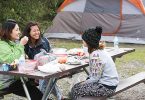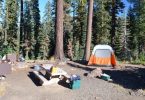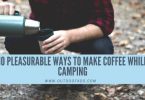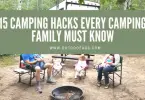We may receive commissions when you buy through the links on our site. Full Disclaimer.
Ever woken up shivering in your tent despite your supposedly “warm enough” quilt? You’re not alone! I’ve spent countless nights testing different sleep systems in frigid conditions, and I’ve discovered that the secret to staying toasty isn’t always buying that expensive winter bag – it’s learning how to layer effectively.
Whether you’re a weight-conscious backpacker or a budget-minded camper, quilt layering might just be the game-changing technique you need to extend your camping season without breaking the bank. You’ve landed on the right guide to transform your existing gear into a cold-weather sleep system that can handle temperatures you never thought possible!
Let’s unlock the secrets to comfortable camping in any season!

Why Quilt Layering Is a Game-Changer for Cold Weather Camping
When winter approaches, most campers face a tough choice: invest in an expensive specialized winter sleeping bag or hang up their boots until spring. But there’s a brilliant third option that experienced adventurers swear by – layering your existing quilts!
Cost Efficiency That Makes Sense
Why buy a $500+ winter sleeping bag when you can combine gear you already own? By layering a 40°F summer quilt with your 20°F three-season quilt, you can create a system that handles temperatures down to an impressive -10°F. Your wallet will thank you!
Temperature Extension Magic
The math is simple but powerful. Enlightened Equipment’s system combining a 40°F Revelation APEX synthetic quilt with a 20°F Enigma down quilt creates a modular sleep system that performs well below zero. This adaptability means you’re prepared for unexpected weather changes without overpacking.
Lightweight Without Compromise
Two-quilt systems can be 30-40% lighter than comparable winter sleeping bags. I’ve personally saved nearly a pound of pack weight using this approach compared to carrying a dedicated winter bag rated to the same temperature. When every ounce counts on long winter treks, this weight savings is incredible.
Four-Season Versatility
The beauty of layering is its adaptability. Too warm? Shed the outer layer. Temperature dropping? Add it back. This modular approach makes your sleep system incredibly versatile across different camping scenarios and changing weather conditions.
The Science Behind Smart Layering: Down vs. Synthetic
Understanding the properties of different insulation types is crucial to creating an effective layered system. Let’s break down why material choice matters so much.
Down Insulation: The Warmth Champion
Premium down (850-900 fill power) provides an unbeatable warmth-to-weight ratio. It’s incredibly compressible and lofts beautifully to create dead air space that traps body heat. However, down has one critical weakness – it loses most of its insulating properties when wet.
When using down in your layering system, it should generally be your inner layer, protected from moisture by your outer layers.
Synthetic Insulation: The Moisture Master
Materials like Climashield APEX shine in wet conditions, retaining 80-90% of their insulation efficiency even when damp. They dry faster than down and provide more consistent performance in humid environments. The tradeoff? They’re bulkier and typically heavier than equivalent down insulation.
Synthetic quilts make excellent outer layers in a layered system, where they can shield your down layer from condensation while still providing reliable warmth.
The Hybrid System Sweet Spot
The optimal arrangement combines both materials’ strengths: synthetic on the outside, down on the inside. This hybrid approach gives you moisture resistance where you need it most while maintaining the superior loft and warmth-to-weight benefits of down where it’s protected from moisture.
In practice, this might look like an Enlightened Equipment Revelation APEX synthetic quilt (outer layer) protecting an Enigma down quilt (inner layer) – combining the best properties of both materials.
Temperature Rating Math: How to Calculate Your Combined Warmth
One of the most common questions I hear is: “How warm will my quilts be when layered together?” While there’s no perfect formula, there is a reliable rule of thumb that has proven accurate in real-world testing.
The Layering Formula
The combined temperature rating of two quilts can be approximated as:
(Quilt A rating + Quilt B rating) – 20°F
For example, layering a 40°F synthetic quilt over a 20°F down quilt yields an approximate rating of:
(40°F + 20°F) – 20°F = 40°F
This means your combined system should keep you comfortable down to about 40°F. This has been field-verified by numerous winter backpackers and aligned with manufacturers’ recommendations.
Proven Combinations Worth Trying
- 40°F synthetic + 20°F down ≈ -10°F capability
- 30°F down + 50°F synthetic ≈ 10°F capability
- 20°F down + 30°F synthetic ≈ -20°F capability
I’ve personally tested a 30°F down quilt over a 40°F sleeping bag with my camping stove nearby for emergency warmth, and stayed perfectly comfortable in temperatures that dipped into the mid-20s°F.
Real-World Performance Factors
Your actual experience will vary based on several personal factors:
- Sleep style: Side sleepers often feel colder than back sleepers
- Metabolic rate: “Cold sleepers” may need to add 10°F to their target
- Humidity levels: High humidity reduces down’s effectiveness
- Wind conditions: Even mild drafts can significantly impact warmth
Clothing Extends Your Range Further
Don’t forget that adding insulated clothing to your layering system can extend your temperature rating by another 10-20°F. A puffy jacket, warm hat, and insulated pants can make a dramatic difference in extreme conditions.
Step-by-Step Guide to Setting Up a Multi-Quilt System
Setting up your layered quilt system properly can mean the difference between a cozy night’s sleep and a miserable one. Let’s walk through the process for both tent and hammock camping.
Getting the Layer Order Right
The golden rule of quilt layering:
- Inner layer: Your warmer down quilt (closest to your body)
- Outer layer: Your synthetic quilt (exposed to tent/hammock condensation)
This arrangement protects your valuable down insulation from moisture while maximizing the system’s overall warmth.
Secure Attachment Methods

For tent camping:
- Lay your sleeping pad on the tent floor
- Attach your inner (down) quilt to the pad using its native straps
- Use Enlightened Equipment Quilt Adapters or similar products to attach your outer quilt
- Ensure both quilts are centered on the pad with even overhang on both sides
For hammock camping:
- Set up your underquilt on your hammock as usual
- Place your inner (down) quilt inside the hammock
- Drape your outer (synthetic) quilt over top
- Use dual-adjust straps to secure both quilts to your hammock suspension
Footbox Management Techniques
A common problem with layered quilts is compressing the inner quilt’s footbox, reducing its insulating power. To prevent this:
- Partially unzip the outer quilt’s footbox to create more space
- Consider a closed footbox inner quilt with an open/adjustable footbox outer quilt
- Use a larger outer quilt (both longer and wider) than your inner quilt
Draft Prevention Strategies
Drafts are the enemy of a warm night’s sleep. Here’s how to eliminate them:
- Use wider quilts on top (at least 55″ wide for the outer layer)
- Look for quilts with draft collars or Dynamic Tension Control systems
- Tuck sides beneath you or under your sleeping pad edges
- Use sleeping pad wings or waterproofing spray on attachment points to prevent moisture ingress
Essential Gear That Completes Your Layered Sleep System
Your quilts are just one part of a complete cold-weather sleep system. Let’s explore the crucial supporting gear that makes the difference between comfort and a cold night.
Sleeping Pad Requirements
Your sleeping pad’s insulation value (R-value) is absolutely critical in cold weather. Heat loss to the ground can exceed heat loss to air by a factor of 10!
- For winter camping (below 20°F): R-value ≥ 4.0 (preferably 5.0+)
- For three-season use: R-value ≥ 3.0
- For extreme cold (-20°F and below): R-value ≥ 6.0
I recommend the Therm-a-Rest NeoAir XTherm (R-value 6.9) for serious winter adventures or stacking two pads for maximum insulation.
Supplemental Insulation Options
Several accessories can extend your system’s temperature rating:
- Sleeping bag liners: Add 5-15°F of warmth (Sea to Summit Thermolite is excellent)
- Vapor barrier liners: Prevent moisture buildup in extreme cold
- Down booties: Keep feet warm where circulation is poorest
- Hot water bottles: Pre-warm your footbox for immediate comfort
Clothing Integration
Your clothing forms an additional layer in your sleep system. Key pieces include:
- Insulated puffy jacket (worn while sleeping adds ~10°F warmth)
- Wool or synthetic base layers (avoid cotton at all costs)
- Insulated hat or balaclava (prevents significant heat loss)
- Heavyweight wool socks dedicated for sleeping
Together with your camping kitchen for preparing hot drinks and meals, these elements create a comprehensive cold-weather system.
Top Quilt Combinations and Products Worth Investing In
After testing dozens of combinations, here are my top recommendations for layered quilt systems at different price points and temperature ranges.
Best Synthetic Outer Options
- Enlightened Equipment Revelation APEX (40°F)
- Weight: 22oz (regular size)
- Features: Full-length zipper, adjustable footbox
- Price: ~$170-220
- Best for: Moisture protection, versatility
- Hammock Gear Economy Burrow (40°F)
- Weight: 24oz (regular size)
- Features: 2.5oz Climashield APEX, draft collar
- Price: ~$160
- Best for: Budget-conscious campers
Recommended Down Inner Layers
- Enlightened Equipment Enigma (20°F)
- Weight: 19oz (regular size)
- Features: 850-fill down, sewn footbox
- Price: ~$325-380
- Best for: Ultralight backpackers
- UGQ Outdoor Bandit (10°F)
- Weight: 22oz (regular size)
- Features: 800-fill down, DTC draft collars, dynamic footbox
- Price: ~$290-340
- Best for: Cold sleepers needing extra draft protection
Essential Accessories
- EE Quilt Layering Adapters: $15, essential for secure attachment
- Therm-a-Rest Coupler Kits: $25, ideal for couples sharing a layered system
- Sea to Summit Thermolite Reactor Liner: $65, adds 8°F warmth with minimal weight
Pro Tips for Maximizing Warmth in Your Layered System
After years of refining my quilt layering technique, I’ve discovered several tricks that make a huge difference in cold conditions.
Pre-warming Techniques
Never climb into a cold quilt system if you can help it! Try these pre-warming methods:
- Fill a Nalgene bottle with hot water and place it in your footbox 15 minutes before bed
- Do jumping jacks or other light exercise right before getting in
- Warm key items like socks and hats near your body before sleep
<h3




